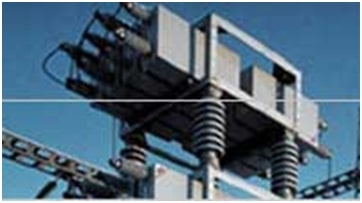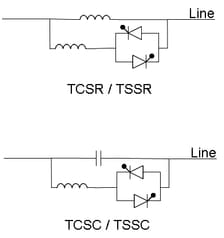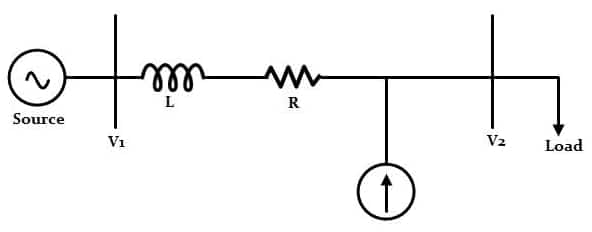
Let your fellow electrical engineer A.N tell you about that! If you want to publish articles just like him, please send a mail to the team.
Why FACTS are required
The power consumption has changed over time, and today’s power sources and usage are different from what the power systems were originally designed for.
The transmission systems are required to supply complex loads in addition to being fed from different power sources that range from hydro, nuclear, geothermal, solar, wind and more. To accommodate the diverse and complex power sources and load patterns, the transmission systems should be flexible and able to react to any changes without affecting the power quantity and quality to the loads.

Parallel capacitor and reactor | image: paktimenergy.com
The FACTS devices are designed to dynamically control the parameters such as the voltage, phase angle and impedance of voltage transmission lines. The devices are usually connected in either series or parallel configurations.
Series connection of FACTS Controllers
This involves inserting the reactive power, such as a fixed series capacitor (FSC) or Thyristor-valve controlled systems (TCSC) into the transmission lines.
Fixed Series Capacitor (FSC)
The fixed series capacitor (FSC) comprises of capacitor banks and is the most cost effective and simple type of series connection. It uses parallel arrestors such as Metal oxide varistors (MOVs) to provide protection, and a bypass switch and spark gaps for isolation.
The series connection increases the transmission efficiency as well as reducing the transmission angle.
Thyristor-controlled Series Capacitor (TCSC)
This is a reactive power compensation that uses the Thyristor-controlled Series Capacitor (TCSC). The TCSC is made by adding a controlled reactor across the series capacitor. The reactor, which is controlled by the thyristor operates in parallel with the capacitor. This combination helps in providing variable as well as a continuous compensation system.

Series compensation | image: wikipedia
Parallel configuration of FACTS Devices
In the parallel compensation method, a switched or controlled system is connected parallel to the transmission lines, usually done at the power system node.
Mechanically Switched Devices
The most common devices used in the parallel systems are the Mechanically Switched capacitors (MSC) and Mechanically Switched Reactors (MSR).The mechanically switched devices provide the most economical reactive power compensation.
The MSCs are simple; however, there response is slow for effective network stabilization and voltage control. The capacitors increase the voltage at the point of connection, but have little effect on short circuit power.
The MSRs are the opposite of the MSCs and preferred for stabilizing the systems when the load is low.
A more advanced MSC is the MSCDN. This is basically an MSC with a damping circuit to prevent the system resonance.

Parallel FACTS compensation | image: electronicshub.org
Static Var Compensator (SVC)
The SVCs provides a fast and reliable method of controlling the voltage as well as the system nodes.
The method involves changing the reactive power which is achieved by either controlling or switching the capacitive or inductive reactive power components that are usually connected on the transformer secondary.
For example, when the system voltage is low, the capacitor bank can be switched on and off using a thyristor. In this case, the SVC will provide a capacitive reactive power and increase the voltage in the system. If the system voltage is high, the SVC provides an inductive reactive power that reduces the system voltage.
Advantages of using the FACTS
There are both technical and financial benefits:
- The existing transmission hardware is utilized better
- Increased availability, efficiency and reliability of the transmission network
- Improved power quality and stability
- Ability for the system to dynamically maintain a stable power
- Environmental benefits
- Increased revenue for the power companies, since there is an increased transmission capacity
- Less outages that translate to increased production and reduced losses for industrial consumers
Determining type and rating of a FACTS
The choice of the FACTS size and rating depends on the existing system condition, configuration and tasks to be performed.
This starts with a network study to identify the critical conditions of the grid and its connections. The analysis should look at the risk issues such as voltage collapse, power swings, undesired power flows, subssynchronous resonances, etc.
If there are no power quality issues such as when the grid is stable, it is also important to investigate if FACTS can be used to optimize the utilization of the lines such as increasing the transmission capacity.
After determining that there is an opportunity to improve the transmission system either by increasing the stability or transmission capacity, the appropriate type and rating of the FACTS device is selected.
The investigation should establish the benefits of installing the FACTS and compare the cost and benefits between the FACTS and conventional methods.
Conclusion
Today’s power generation and consumption are always changing due to the different sources of power and diverse nature of load. These can lead to unstable power and unreliable power transmission.
The FACTs technology can reliably respond to the dynamic variations in the electric power arising from changes in load or amount and quality of power generated. This helps the electricity companies to improve the power quality, maximize the use of existing assets, increase flexibility and reliability of the systems.
Thank you for reading my material,
A.N.
Comment below if you have any question or remark to do to!